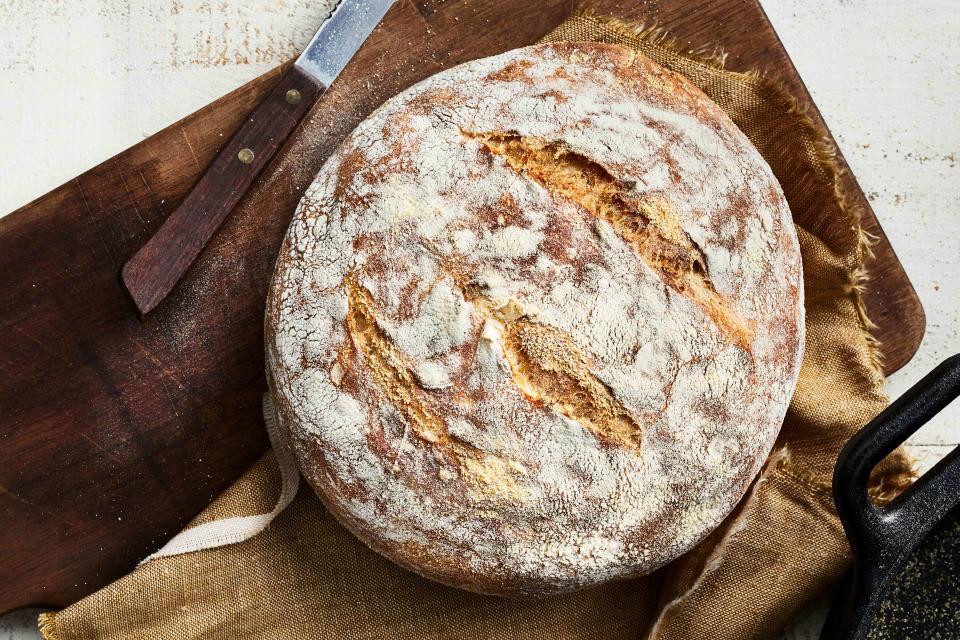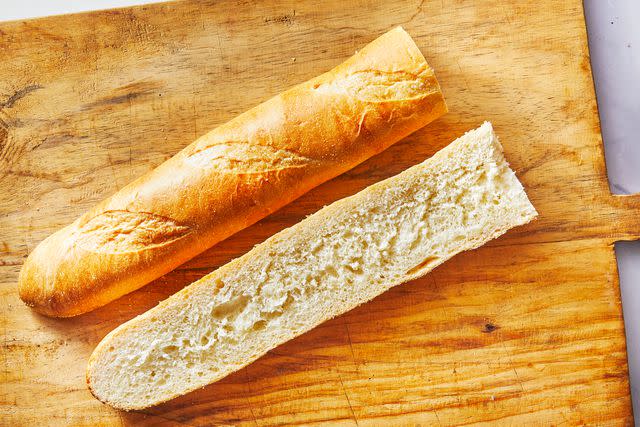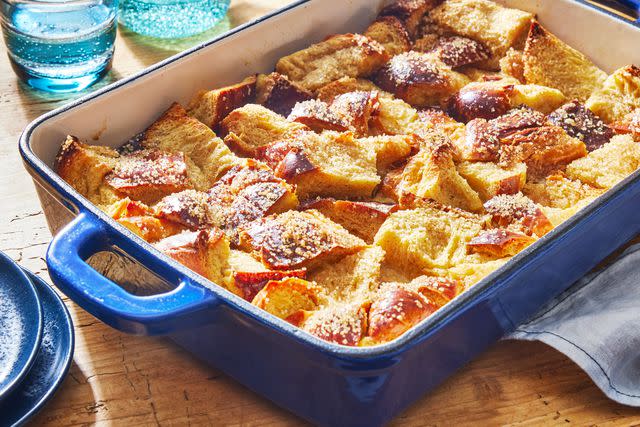The Best Way To Keep Your Bread Fresh, According To A Baker
It's not in the fridge.

Greg Dupree; Prop Styling: Cindy Barr; Food Styling: Chelsea Zimmer
A good loaf is not something to waste, which is why it's important to learn how to store bread properly. Whether you buy artisanal sourdough or pick up something from the bakery at the local supermarket, the same principles apply (you don't want to put in the fridge). We consulted a professional baker about the best way to store bread, as well what not to do, and how to use bread up if it does go stale on you.
Related: Our Most Popular Bread Recipes Of All Time
Kevin Scollo
Over the last 15 years, Kevin has worked in restaurants and bakeries in New York City and Cleveland, Ohio, including Lolita, Bien Cuit, The NoMad Hotel, and The Great Northern Food Hall.
In February of 2020, Kevin was grateful for the opportunity to acquire Independent Baking Company in Athens, Georgia from Thom Leonard, and has enjoyed baking for the community there. Kevin is also a classically trained percussionist, with a music performance degree from the Oberlin Conservatory of Music in Oberlin, Ohio.
How to Store Bread at Room Temperature
Here's what to keep in mind when storing your fresh bread on the counter.
Paper is better than plastic
Have you ever noticed how most bread bakeries package bread in a paper bag? There's a reason for that. Plastic traps moisture, and moisture unfortunately promotes mold.
"If you store your bread at room temperature in plastic it will certainly keep it softer, however you will sacrifice shelf life. Especially in the American South where it is humid all of the time, you are inviting mold to infest your loaf by trapping in all of the moisture," says Kevin Scollo, a professional baker and owner of the Independent Baking Company in Athens, Georgia.
Keeping the bread in the bag it came in also happens to be the best way to store it at room temperature, according to Scollo. He does note that how long a loaf will last stored this way can vary greatly based on the kind of bread you purchased. "Most yeasted breads (baguettes, ciabatta) will last 1-2 days. Sourdough loaves (unsliced) can last at least 5 days to over a week on the counter, depending on the size of the loaf," he says.
What about a bread box?
Some people will tell you that you absolutely must have a bread box. If you have the counter space, and eat plenty of bread, it might be worth investing in. Luckily for those of us with limited space, it's not really a kitchen nonnegotiable.
"I, personally, have never used a bread box, although it will keep your loaf fresher for a longer period of time than just leaving it exposed on your counter. I do not think they are a necessity, but rather a preference for keeping bread fresh," says Scollo.
Slice as you go
Simply put, don't slice off more than you can eat.
"You want the least amount of crumb exposed to air so that it stays softer for longer. Once you start slicing into your loaf, you can still store it in the paper bag it came in. Just make sure that the cut area of the loaf isn't exposed to air. Another option is to just keep the loaf cut-side down on your cutting board if you are going to go through it quickly," says Scollo.

Caitlin Bensel; Food Stylist: Torie Cox
Don't store bread in the fridge
Storing bread in the fridge is a quick way to dry it out. It might seem counterintuitive, as you typically turn to the fridge to give all sorts of foods a longer shelf life, from ketchup to lemons, but bread is one item where this rule doesn't hold true. The science behind it (in short) is that the starch in bread recrystallizes and that causes the loaf to lose moisture.
"Either keep it at room temperature or put it in plastic and store in the freezer. The only loaves I have found that do decently in the fridge are 100% rye breads such as Danish rugbrød," says Scollo.
Related: Should You Refrigerate Bread To Make It Last Longer?
How to Freeze Bread
Enjoying bread fresh is certainly the best case scenario, but if you know that you won't go through the whole loaf in a timely manner, freezing is the next best option.
Scollo recommends wrapping the loaf (whole or sliced) in plastic wrap and then a layer of aluminum foil (or you can place it in a zip-top bag). The additional layer of wrapping helps prevent freezer burn. Speaking of which, while freezing sliced bread is certainly more convenient for defrosting later on, it can become freezer burned much faster. If you consume the slices within a few weeks, Scollo says it should be fine.
To defrost bread, Scollo suggests taking the loaf out the night before to defrost on the counter. But don't even think about using 'Chef Mic.' "Microwaving [frozen bread] will destroy the texture of the loaf," he says.
Tips
"If your loaf is a bit hard but you want to reheat it in the oven for dinner, I've found that spritzing the crust with a bit of water before reheating it revives the crust nicely," says Scollo.
What to Do with Stale Bread
"If you've stored your loaf in paper, you can usually let your loaf get extremely hard and dry without seeing any signs of mold. At this point, there are so many great ways to use stale bread," says Scollo.
Bread pudding has long been one of the most popular ways to put stale bread to good use (French toast, too), but the list doesn't end there.

Caitlin Bensel; Food Stylist: Torie Cox
Here are a few of Scollo's favorite ways to use stale bread:
"You can also grind up the stale bread into breadcrumbs and use them for meatballs, for breading meat or vegetables, or for topping casseroles and mac and cheese. You can also toast the breadcrumbs in oil to make a crunchy topping for pasta dishes, etc."
"If you're making a brothy soup, you can toast a piece of stale bread in oil in a skillet and ladle the hot soup over it to rehydrate it. It makes a thin soup very hearty. There are also soups and sauces like Ribollita and Romesco, that use stale bread as a thickener."
"You can make croutons for salads. Or if you have stale slices, toast the slices and make crostini for bruschetta, chicken liver mousse, or any variety of toppings."
The only thing Scollo doesn't recommend? Throwing away your stale bread!
For more Southern Living news, make sure to sign up for our newsletter!
Read the original article on Southern Living.

